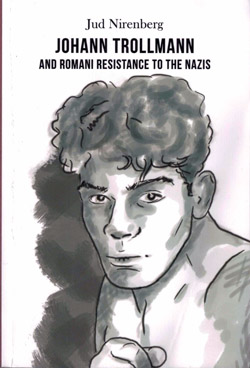Johann Trollmann and Romani Resistance to the Nazis by Jud Nirenberg; KO Publications; (c) 2016; ISBN 978-0-9903703-76; 220 pages.
By Donald H. Harrison

 SAN DIEGO — Despite some problems in its organization, this is an important book for the Jewish community to ponder. Utilizing the story of Johann Trollman– a Sinto boxer who in 1933 fought his way to Germany’s light heavyweight championship, only to have his victory annulled by the Nazis–author Nirenberg, a Rom, tells the all-but-forgotten history of the Holocaust against his people and Trollman’s, who together are called “Gypsies” by others.
SAN DIEGO — Despite some problems in its organization, this is an important book for the Jewish community to ponder. Utilizing the story of Johann Trollman– a Sinto boxer who in 1933 fought his way to Germany’s light heavyweight championship, only to have his victory annulled by the Nazis–author Nirenberg, a Rom, tells the all-but-forgotten history of the Holocaust against his people and Trollman’s, who together are called “Gypsies” by others.
The book bobs and weaves–even as Trollman did in the ring — between stories about the fight game and stories about the rise of Nazi Germany. Although Trollman enlisted in the German Army at the beginning of World War II, he eventually was imprisoned, and after being forced to participate in an exhibition match against a kapo, which he won, he was murdered with a shovel smashed against his head. T
Trollman’s death occurs at approximately the two-thirds mark of the book, with the rest of it being a history of the Roma and Sinti communities’ efforts to win recognition of the fact that like the Jews, they too were the objects of mass murders. By Nirenberg’s account, one-half million Sinti and Roma were systematically isolated, tortured, and murdered.
The book is particularly critical of the U.S. Holocaust Memorial Museum in Washington D.C. for confining an exhibit of the Roma and the Sinti to a small section of the museum. Author Nirenberg argues that such artifacts as “a violin, a wagon and a woman’s dress” play into the stereotype that all Roma and Sinti were nomads, making their living from fortune telling, circuses, and petty thievery. While such images may have applied to some small percentage of his and Trollman’s people, Nirenberg argues, a far larger percentage were people whose families had been settled for generations, earning their livings exactly as other Europeans did.
Nirenberg says while Gypsies have had some important advocates in the Jewish community, notably Simon Wiesenthal and the late U.S. Rep. Tom Lantos, other segments of the Jewish community — particularly those involved with memorializing the Holocaust — have shunted them aside. Among thse who come in for bitter criticism in this book is Elie Wiesel.
I have attended numerous Holocaust commemorations. Typically six candles are lit in these ceremonies to represent the six million Jews. More recently another candle has been lit to commemorate homosexual victims. Sometimes a candle is lit to commemorate all the “others,” who also died at the hands of the Nazis.
Nirenberg’s book puts the question front and forward whether the murders of the Sinti and the Roma also should be specifically mourned at such ceremonies, and further, if members of the Jewish community should be made aware that it was not the only group whom Hitler had planned to eradicate.
In Europe, more and more countries are responding positively to the pleas for recognition from the Roma (and Sinti) communities; establishing August 2nd as International Roma Holocaust Day.
*
Harrison is editor of San Diego Jewish World. He may be contacted via donald.harrison@sdjewishworld.com. Comments intended for publication in the space below MUST be accompanied by the letter writer’s first and last name and by his/ her city and state of residence (city and country for those outside the United States.)
Pingback: Recognition of Rroma Holocaust - rroma.org